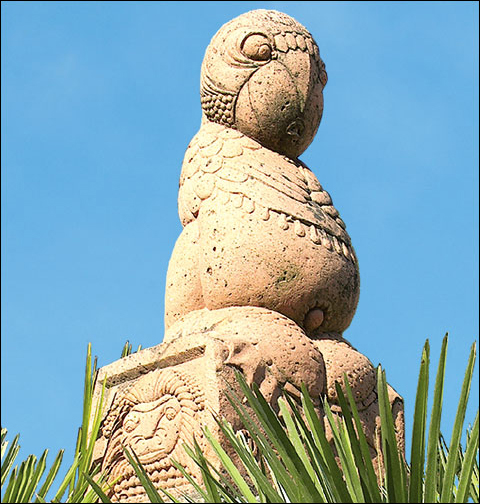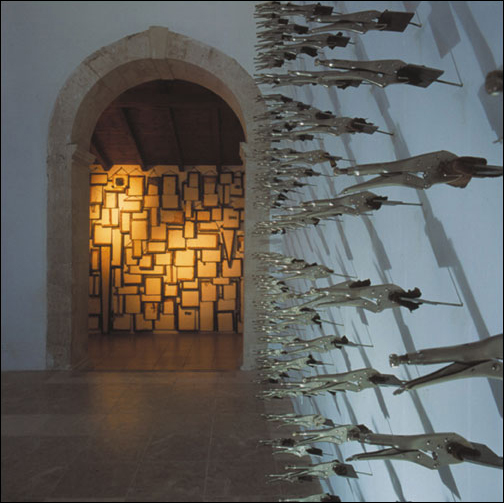La Napoule Revisited
As Italian critic Enrico Pedrini and I drove to La Napoule, memories of my 2002 artist’s residence flitted about my mind. For two months I had worked as an artist in residence at this chateau just west of Cannes on the French Riviera. The American La Napoule Art Foundation owns and manages an 11th century castle complete with medieval style gardens and soaring Saracen towers. Artists from all nations and disciplines are welcome to apply for the residency. Next door to the castle, facing the sea, is the Belle Epoque Villa Margarita which houses visual artists, poets and writers. Studio space for visual artists is also provided in the Villa Margarita.

Henry and Marie Clews
La Napoule originally served as the residence and studio space of American artist Henry Clews. Scion to a New York banking fortune, Clews moved to Paris several months after his marriage to New York socialite Marie Clews in 1914. There he committed himself to the development of his art as a figurative sculptor. The havoc of World War I and a Spanish Flu epidemic, prompted Henry to take his family to the relative safety of Southern France where a real estate broker showed them the Chateau de La Napoule.

Henry and Marie decided to buy the chateau and set to work renovating it in the most fanciful way. Clews carved gargoyles and pediments depicting hybrids of men, women and animals appertaining to a personal mythology. Marie dedicated herself to the garden, which grew into a peaceful haven framed with lanes of Eucalyptus and crowned with a Henry Clews sculpture titled the “God of Humormystics.” Henry passed away in 1937 and, after World War II, Marie Clews and her son Mancha created a foundation that would, in perpetuity, offer artist’s residencies, host exhibitions, publish books and catalogs, and preserve the artistic legacy of Henry Clews.
The Residency
Shortly after 9.11 I won a residency to La Napoule Art Foundation. After months of breathing acrid smoke near the World Trade Center it felt vaguely surreal to arrive on the French Riviera. I was assigned a large room in the Villa Margarita with high ceilings, a marble fireplace, and banks of windows overlooking the Mediterranean and a private garden replete with palm trees, succulents and mimosa. As a conceptual artist I felt less akin to the work of artists like Picasso (late), Matisse, Renoir and Chagall who were drawn to the Riviera by its special light and colors. But such avant-gardists as Jean Cocteau and Yves Klein also heeded the siren song of the Riviera.

The evening of my arrival I met the other residents and they were all women, save for one French artist who appeared for a day and disappeared just as mysteriously. There was an English expatriate residing in Cambodia who brought plentiful orchid stems to the encounter. A rough and ready Midwesterner was there, delighted with her apartment in the castle. She would later spend considerable time exploring secret passages and vertigo inducing stairs within medieval battlements. Rounding off the residents were two New Yorkers. One, a young Brooklynite with short-cropped hair and a vitriolic disposition, produced web-like sculptures spun from lamb’s wool in her Villa Margarita studio. The other was an affable poet, who could often be seen writing from her balcony perch above the sea at the Villa Margarita.

The Napoule residency represented my first and only experience with an artist’s colony, but I found the time very helpful. Mandelieu-La Napoule is served by a commuter train which carries passengers to Nice (30 minutes away) while passing through such towns as Cannes and Antibes. Pedrini had introduced me to a number of French artists including Nadine Spinoza, Stéphàne Steiner, Junko Yamasaki, Jean Robert Cutaia, members of the collaborative group La Station and Fluxus old guardian Ben Vautier. Each day I would rise in the early morning, board the train, and travel to Nice or environs to produce new photography for an ongoing project of mine. The castle, cuisine, weather, light and sea were all magnificent. Meals for artist residents are prepared by a French caterer in Cannes and are delectable. The most interesting aspect of the residency, however, was undoubtedly living among the French and particularly French artists. I have visited Nice and La Napoule on five separate occasions and continue to find the Niçois enigmatic, charming, cultivated, intelligent (at times quite brilliant) and consistently fascinating. I would recommend the residency to anyone in the arts.
© Daniel Rothbart, 2006.